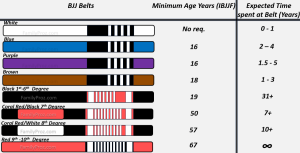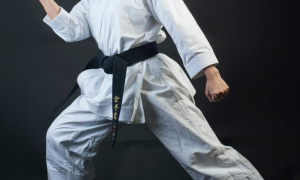
Brazilian Jiu-Jitsu, a martial art known for its technical precision and strategic prowess, has captured the fascination of countless practitioners around the world. As aspiring students enter the realm of Jiu-Jitsu, they encounter a system of recognition that signifies their progress and skill level: the BJJ belts system.
More than mere colored accessories, these belts carry profound meaning and serve as milestones on the journey towards Jiu-Jitsu mastery.
Through an exploration of the belt colors, time-frames, and the ongoing journey beyond the black belt, we will unravel the fabric of the BJJ belt system.
Table of Contents
ToggleBJJ Belt Timeline
The journey through the Brazilian Jiu-Jitsu belt system is not a race. It is a testament of dedication and perseverance.
A typical length of time to achieve a BJJ Black Belt is 5 – 10 years. With the time required to advance ranks within the black belt taking exponentially longer.
Brazilian Jiu-Jitsu Adult Belt System

Brazilian Jiu-Jitsu Belt Order
- White
- Blue
- Purple
- Brown
- Black 1st-6th Degree
- Coral Red/Black 7th Degree
- Coral Red/White 8th Degree
- Red 9th -10th Degree
BJJ belt stripes

In addition to the colored belts, Brazilian Jiu-Jitsu utilizes a system of belt stripes to further recognize a practitioner’s progress and achievements. Belt stripes are thin, usually tape-like, pieces of fabric that are attached to the colored belts. These stripes serve as smaller increments of advancement within each belt rank, highlighting specific milestones and areas of development.
The number of belt stripes awarded differs based on the belt rank. White, Blue, Purple, and Brown belts offer the opportunity to earn up to four stripes, while Black Belts can have up to six stripes. Coral Belts, reserved for esteemed practitioners, carry 7-8 stripes, while the prestigious Red Belts, awarded to Grandmasters, are adorned with 9-10 stripes.
![]()
BJJ White Belt
Minimum Age: Any age can achieve a BJJ White Belt
Expected Time Spent at Belt: Anywhere between 0 – 1 years. Dependent on the commitment of the practitioner.
Similar to many other martial arts, Brazilian Jiu-Jitsu (BJJ) commences its belt system with the white belt. Traditionally, the Jiu Jitsu white belt had no stripes or degrees to indicate progress. However, in modern practice, many BJJ schools have adopted the use of stripes as markers of advancement within the white belt rank.
In the realm of BJJ, the white belt holds a special significance. It is considered the foundation upon which all subsequent skills and techniques are built. As a result, some schools emphasize a prolonged period of time for practitioners to develop a strong understanding of the fundamentals, even though there is no official minimum duration for the white belt rank.
What percentage of BJJ white belts quit?
Determining the exact percentage of BJJ white belts who quit is challenging and very dependant on the academy/individual. However a conservative estimate would be that 70%+ of BJJ practitioners quit during their white belt.
Can white belts compete in BJJ?
Yes, white belts in Brazilian Jiu-Jitsu (BJJ) can participate in competitions. While most white belt competitions occur within their own BJJ academies as in-house tournaments, it is also possible for white belts to compete in external tournaments.
How long are you a white belt in BJJ
The duration of time one remains a white belt in Brazilian Jiu-Jitsu (BJJ) can vary depending on the guidelines set by the academy they attend. On average, for a dedicated practitioner who trains regularly, it is common to spend approximately 1 year as a Jiu-Jitsu white belt before progressing to the next belt rank.
![]()
BJJ Blue Belt
![]()
Minimum Age: 16+
Expected Time Spent at Belt: The time one spends at blue belt level is typically 2-4 years.
A BJJ Blue belt represents a significant milestone in a practitioner’s journey, signifying a solid foundation and a deeper understanding of Brazilian Jiu-Jitsu.
How long to get a blue belt in BJJ?
On average, one can expect to spend approximately 1 year working towards a Blue Belt in Brazilian Jiu-Jitsu. However, it’s important to note that the specific duration may vary depending on the time requirements and guidelines set by the individual’s academy. Each academy has its own curriculum and progression criteria, which can influence the timeline for advancing from the white belt to the BJJ Blue Belt.
![]()
BJJ Purple Belt
![]()
Minimum Age: 17+
Expected Time Spent at Belt: The time one spends at purple belt level is typically 3-5 years
The Jiu-Jitsu purple belt is often considered the longest transitional belt during the “White to Black belt” journey, typically taking an average of 3-5 years to progress from. This belt signifies a significant step in a practitioner’s Jiu Jitsu career. Involving the introduction of more advanced techniques that require years of dedicated training to master to a sufficient level.
How long to get a purple belt in BJJ?
To progress from a white belt to a purple belt in Brazilian Jiu-Jitsu (BJJ), it typically takes an average of 3 to 5 years of consistent training and dedication. This timeline is based on the assumption that the practitioner starts from scratch without any prior experience in BJJ.
![]()
BJJ Brown Belt
![]()
Minimum Age: 18+
Expected Time Spent at Belt: The time one spends at brown belt level is typically 2-3 years
Jiu Jitsu Brown belts are often regarded as seasoned practitioners who possess a wide range of techniques and can adapt their skills to various situations with precision and efficiency.
How long to get a BJJ brown belt?
The journey to achieve a brown belt in Brazilian Jiu-Jitsu (BJJ) typically takes anywhere from 5 to 8 years of dedicated training and consistent progression. This estimate is based on the average timeline for practitioners who start from the beginning without prior experience in BJJ.
![]()
BJJ Black Belt
![]()
Minimum Age: 19+
Expected Time Spent at Belt: The time one spends at black belt level is typically 31+ years
A black belt in Jiu-Jitsu represents a remarkable level of mastery and expertise. It symbolizes years of dedication, hard work, and a deep understanding of the technical aspects, principles, and strategies of Jiu-Jitsu. Black belts are highly respected within the Jiu-Jitsu community and are regarded as role models, mentors, and lifelong students of the art.
How long to get a Black belt in BJJ?
The journey to achieve a black belt in Brazilian Jiu-Jitsu (BJJ) typically takes anywhere from 8 to 12 years of dedicated training and continuous progress. This estimate is based on the average timeline for practitioners who start from the beginning without prior experience in BJJ.
![]()
Learn about other Martial Arts Belt systems in our articles on the:
![]()
BJJ black belt with white bar vs red bar

Traditionally, some schools incorporated a white bar on a black belt, indicating that the individual was a black belt holder but not involved in any teaching program. However, in contemporary practice, it has become more common for practitioners to receive a black belt with a red bar, regardless of their involvement in a teaching program.
![]()
BJJ Black Belt Stripes (Degrees)

The Jiu-Jitsu black belt encompasses a progression from 1st to 6th degree, with each degree requiring from 3 -5 years of dedicated training to attain. After which the 7th, 8th, 9th and 10th degrees can be earned. It stands as a coveted goal that many aspiring BJJ practitioners strive to achieve, representing a remarkable milestone in their journey.
- Minimum time spent at Black Belt level is 31 years
- To achieve a 6th Degree Black Belt you must be at least 43 years old
![]()
BJJ Red and Black Belt (Coral Belt)

When a practitioner of Brazilian Jiu-Jitsu reaches the seventh degree of black belt, they are honored with a distinct symbol of their mastery—an alternating red-and-black belt. This belt represents a significant milestone in their journey,
Minimum Age: 50+
Expected Time Spent at Belt: The time required at 7th degree black belt is 7+ years
BJJ Red and White Belt (Coral Belt)

In 2013, the International Brazilian Jiu-Jitsu Federation made amendments to the graduation guidelines pertaining to the progression from the seventh degree to the eighth degree black belt. As per the revised guidelines, practitioners who attain the prestigious rank of an 8th degree black belt will wear a distinguished red and white belt.
Minimum Age: 57+
Expected Time Spent at Belt: The time required at 8th degree black belt is 10+ years
![]()
BJJ Red Belt

In the realm of Brazilian Jiu-Jitsu, the red belt holds a special distinction, reserved for individuals who have reached the pinnacle of mastery and gained widespread influence and fame within the art.
Minimum Age: 67+
![]()
List of Kids BJJ Belts + Age Requirements

- White (Any Age)
- Gray + White Stripe (4-15)
- Gray (5-15)
- Gray + Black Stripe (6-15)
- Yellow + White Stripe (7-15)
- Yellow (8-15)
- Yellow + Black Stripe (9-15)
- Orange + white Stripe (10-15)
- Orange (11-15)
- Orange + Black Stripe (12-15)
- Green + White Stripe (13-15)
- Green (14-15)
- Green + Black Stripe (15-15)
How many belts are there in Jiu-Jitsu for kids?
In total there are 13 Kids BJJ Belts which take a minimum of 8 months to progress from each one. The belts in order are: White, Gray + White Stripe, Gray, Gray + Black Stripe, Yellow + White Stripe, Yellow, Yellow + Black Stripe, Orange + white Stripe, Orange, Orange + Black Stripe, Green + White Stripe, Green, and Green + Black Stripe.
Can kids get black belt in BJJ?
While several martial arts disciplines allow children to attain the rank of Black Belt, Brazilian Jiu-Jitsu (BJJ) follows a more stringent approach in its belt promotion system. Unlike other arts, BJJ imposes stricter guidelines, and the minimum age requirement to achieve a black belt is set at 19 years old. It is worth noting that reaching the level of a black belt at such a young age is a rarity.
![]()
Compare the BJJ Belts Sytem with Taekwondo in our article.
![]()
FAQ
What are BJJ coral belts?
BJJ coral belts are an elite rank within Brazilian Jiu-Jitsu, representing the 7th and 8th degree Black Belts. They come in 2 variations, a Red and Black Belt representing the 7th degree and a Red and White Belt (introduced in 2013) representing the 8th degree Black Belt. Achieving either of these belts requires decades of training.
Who is the youngest BJJ black belt?
Mica Galvao, at just 17 years old, became the youngest BJJ black belt recipient, defying the IBJJF’s 19-year-old minimum requirement. Although the IBJJF isn’t the central governing body for BJJ, the community widely agrees that Galvao’s promotion was well-deserved and justified due to his exceptional talent and dedication.
How many years does it take to get belts in BJJ?
According to IBJJF rules:
|
Belt |
Age Group |
Minimum Time in Grade |
Minimum Total Time Trained |
| White |
Any |
Undefined | Undefined |
| Blue |
16+ |
1 year in previous belt | 1 years |
| Purple |
17+ |
1.5 years in previous belt | 2.5 years |
| Brown |
18+ |
1 year in previous belt | 3.5 years |
| Black Belt |
19+ |
1 year in previous belt | 4.5 years |
| Black Belt 1st Degree |
22+ |
3 years in previous belt | 7.5 years |
| Black Belt 2nd Degree |
25+ |
3 years in previous belt | 10.5 years |
| Black Belt 3rd Degree |
28+ |
3 years in previous belt | 13.5 years |
| Black Belt 4th Degree |
33+ |
5 years in previous belt | 18.5 years |
| Black Belt 5th Degree |
38+ |
5 years in previous belt | 23.5 years |
| Black Belt 6th Degree |
43+ |
5 years in previous belt | 28.5 years |
| Coral Red/Black Belt 7th Degree |
50+ |
7 years in previous belt | 35.5 years |
| Coral Red/White Belt 8th Degree |
57+ |
7 years in previous belt | 42.5 years |
| Red Belt 9th Degree |
67+ |
10 years in previous belt | 52.5 years |
| Red Belt 10th Degree |
82+ |
15 years in previous belt | 67.5 years |


